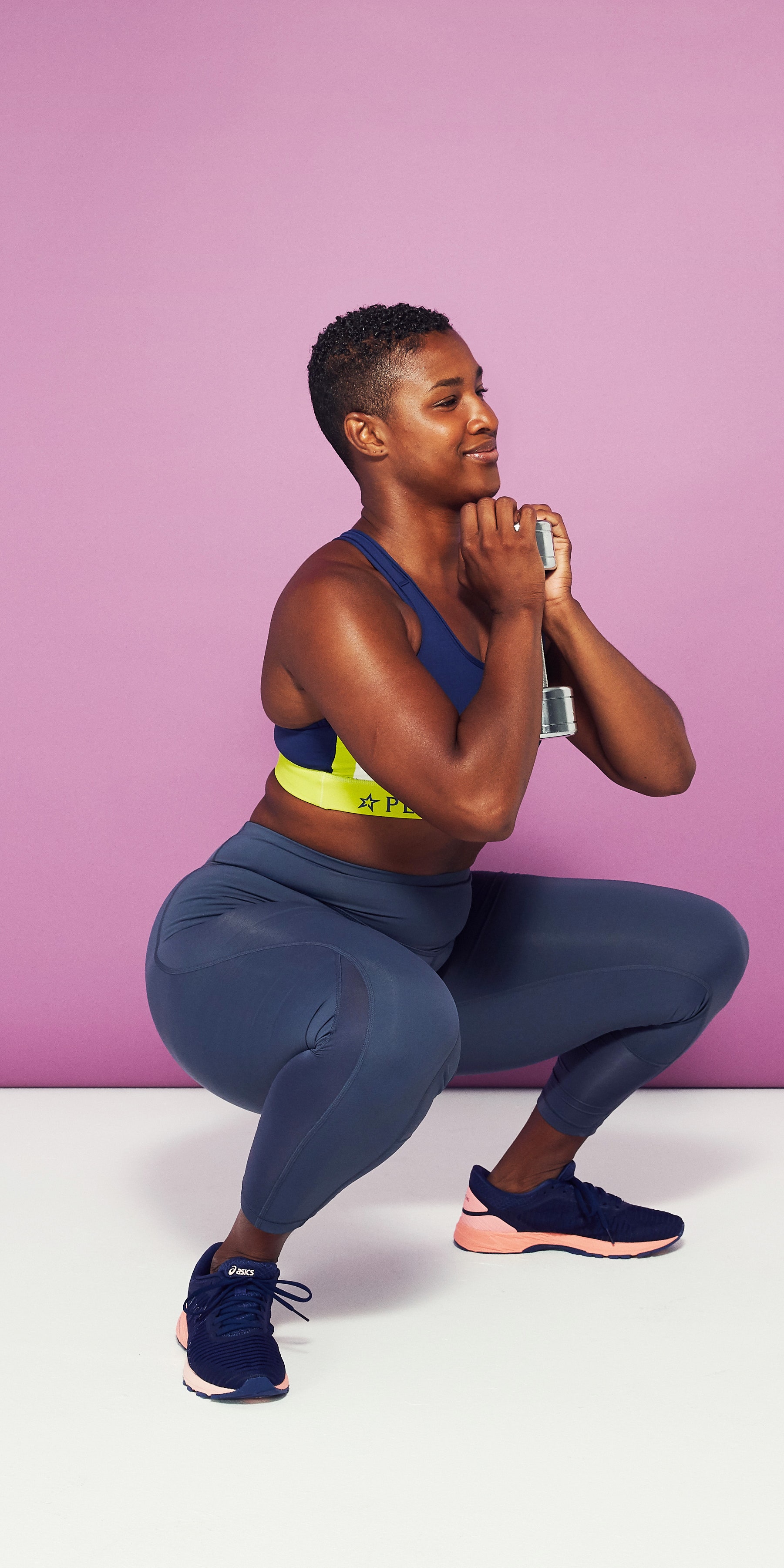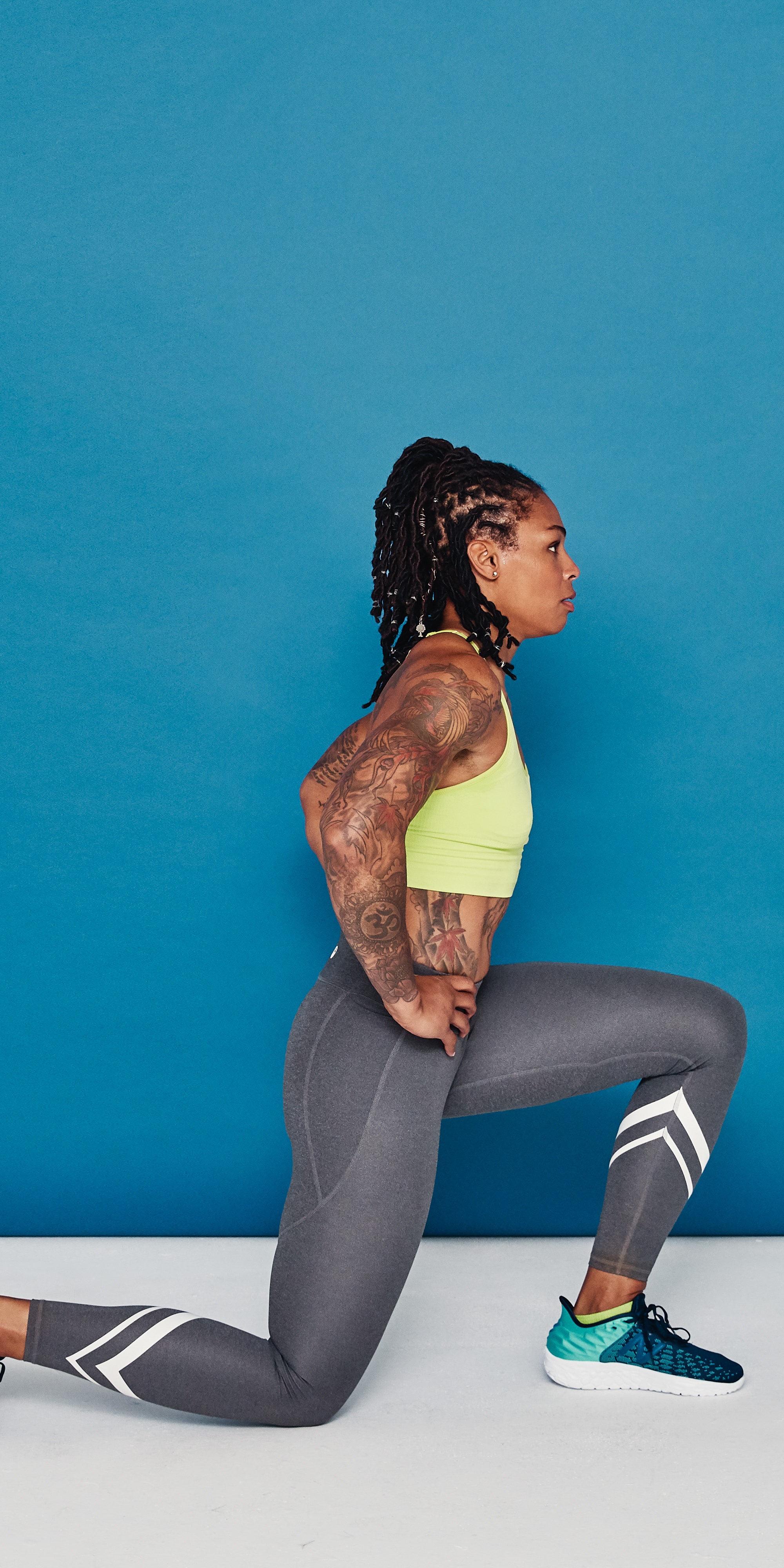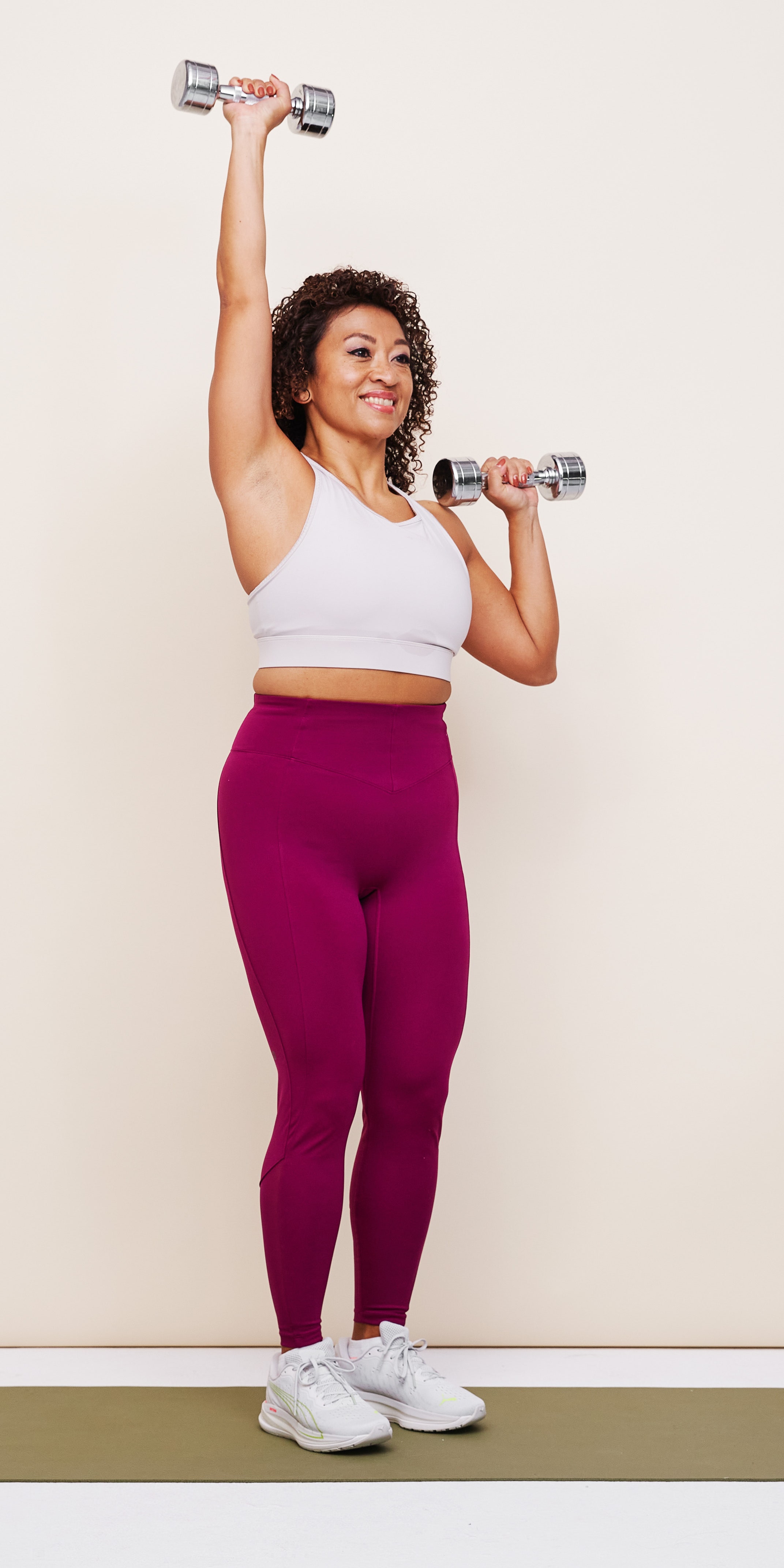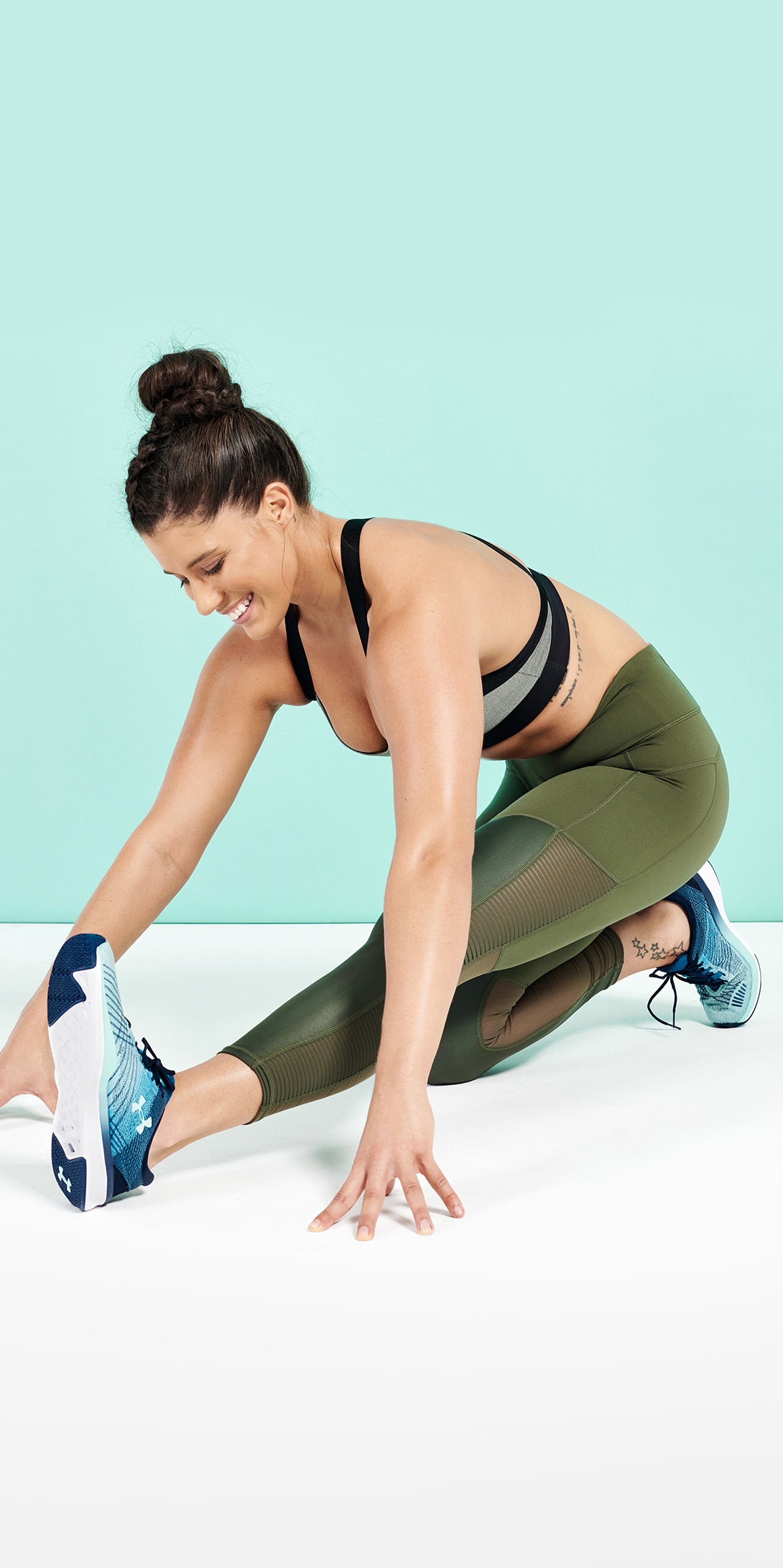Doing knee-strengthening exercises is probably not your number one priority when you visit the gym or plan your at-home workout routine. You may think that knee exercises only matter if you’re an avid marathoner or an elite athlete who’s constantly pummeling the joint. But that’s actually not true: Taking the time to strengthen this important area can go a long way toward boosting overall movement capabilities and reducing injury risk—for anyone.
Your knees play a pivotal role in a lot of daily activities, whether that’s climbing and descending the stairs, running to catch the bus, or even just walking your dog around the neighborhood. As you perform these movements, the knees (along with the feet and ankles) absorb a lot of force, Kellen Scantlebury, DPT, CSCS, founder of Fit Club NY, tells SELF. Because of this, “it’s really important that the knee and the muscles that surround the knee are working optimally,” says Scantlebury.
For that reason, it’s a good idea for all of us to do knee-strengthening exercises, whether we think we need them or not, Kate Bochnewetch, DPT, CSCS, founder of the Running DPT in Buffalo, New York, tells SELF.
With that in mind, we tapped Bochnewetch and Scantlebury for 10 awesome knee-strengthening exercises you can do at home. The experts also shared intel on the best ways to strengthen your knees and why strong knees matter in the first place. Below, all you need to know about this super-important joint.
What are the benefits of strengthening the muscles around the knees?
The knee often follows the movements of the foot and hips, which means issues in either area above or below the knee joint can lead to problems in the knee itself, Scantlebury explains. By strengthening all of the important muscles around the knee, you can improve knee stability and alignment, ultimately protecting it from injury, she says.
Muscles that provide support to the knee include the quadriceps, a group of four muscles on the front thigh that help straighten out the knee and also assist in hip flexion, as well as the hamstrings, or the muscles on the back of your legs that contract at the same time as the quads to provide stability for your knee. Additionally, the glute muscles play a key role in keeping the hips and knees aligned and controlling the knee in side-to-side movements, and your tibialis anterior (muscle on the front part of your lower leg) and calf muscles in the back of the leg “help support the knee from below the joint,” says Scantlebury. Lastly, your adductors (inner thigh muscles) are important as well, since “people who have instability of their kneecap usually have weakness in the adductors or medial muscles in the thigh,” according to Scantlebury.
All the muscles mentioned above need to be strong enough to properly stabilize the knee and keep it safe when it moves—and that’s where knee-strengthening exercises come in.
Knee strength is crucial for overall knee health. And as we mentioned, it’s important for pretty much everyone. But knee-strengthening exercises for runners and other athletes whose sports involve high-impact moves are extra critical, says Bochnewetch. Because these people are asking a little bit more from their knees (and bodies in general), it’s extra important to make sure their joints are strong enough for the tasks at hand.
What are the best knee-strengthening exercises?
The best knee-strengthening exercises target the supporting muscles of the knee, including the quads, hamstrings and glutes, plus the muscles of the inner thighs, calves, and front of the leg. It’s especially key to hit all the muscles of the glutes, including the gluteus medius, a smaller butt muscle that helps your legs move out to the side (a movement called abduction). “It’s a really important muscle when it comes to knee health because that’s the muscle that prevents your knee from caving in when you’re doing single-leg activities,” says Bochnewetch. Yes, that means running, walking, and stair-climbing.
Unfortunately, the glute medius tends to be fairly weak in the general population, says Bochnewetch, which is why you should definitely incorporate moves that specifically target this muscle when designing a knee-strengthening routine.
Another tip, especially if you’re strapped for time? Pick compound exercises, like squats and lunges, which hit several different muscle groups at once instead of isolation moves (like donkey kicks) that focus on just one muscle group. The reason: Compound exercises provide more “bang for your buck,” says Bochnewetch, so you can incorporate more knee-strength work into your routine without adding tons of extra time.
When doing knee-strengthening exercises, make sure to follow the concept of progressive overload, which is when you gradually and continually increase the intensity of your routine by either adding more weight, increasing reps or weights, or reducing your rest time. This ensures you will continue to challenge yourself and improve your strength, says Bochnewetch.
In addition to doing exercises that help strengthen the knee, it’s also important to do moves that increase the stability of the joint, says Scantlebury. You can do this by performing knee-strengthening exercises on various surfaces—like foam pads and BOSU balls—that throw your balance off a bit, or adding some extra coordination challenges, like turning your head side to side while holding a single-leg deadlift, or doing a bicep curl while holding a lunge. (Of course, make sure you have the traditional version of the exercise down first before you add in extras!)
Another good idea: Incorporating isometric exercises into your routine. These are exercises where you get into a position where a muscle or muscle group is engaged, and hold (think: a static lunge or glute bridge hold). Targeted isometric moves can strengthen the tendons that connect to the muscles that control the knee, and thus reduce your risk of issues caused by weak tendons, like knee pain or tendonitis, says Scantlebury.
That said, if you’re looking for knee pain exercises, it’s a good idea to talk to a physical therapist for individualized medical advice for your particular situation. Certain exercises may be contraindicated for certain types of knee pain and overuse injuries, so it’s always a good idea to get a personalized diagnosis and physical therapy treatment plan if you think you have an injury. (Curious about knee stretches? Check out these expert-recommended stretches for knee pain.)
How often should you do knee-strengthening exercises?
You don’t need to slot in knee-strengthening exercises every day in order to see results. In fact, Bochnewetch suggests doing knee-strengthening exercises just two times per week. Pencil them in alongside your usual leg workouts, or as a separate standalone routine, she says.
As a general rule of thumb, do each exercise for 8 to 12 reps and 2 to 3 sets. If you’re using weights, choose a weight that will allow you to perform repetitions at an intensity that feels between a 6 and 8 on a difficulty scale of 1 to 10 (where 10 is the most challenging), Bochnewetch advises. If it’s an isometric exercise, hold for 5 to 10 seconds, and repeat for 5 to 10 reps, says Scantlebury.
10 Knee-Strengthening Exercises
To get started with knee-strength work, Bochnewetch and Scantlebury recommend trying the exercises below. You can pick two to three to add to your lower-body routine and switch it up over the weeks to shuffle through the list. Or, do five or six of them at once for a complete quad- and glute-focused lower-body workout. (If you’re a beginner, pick just three to four moves for the full workout.)
However you choose to incorporate these exercises into your routine, make sure to do a warm-up first so that you don’t jump in with cold muscles. It doesn’t need to be elaborate; a simple 5- to 10-minute walk will do the trick. Or try this bodyweight routine.
Equipment needed: A pair of dumbbells and a resistance band. If these exercises are new to you, stick with bodyweight-only first and work your way up to adding resistance once you’re comfortable with form.
-
Pinterest
Katie Thompson1 Single-Leg Deadlift
- Stand with your feet together, holding a dumbbell in each hand in front of your thighs. This is the starting position.
- Shift your weight to your left leg; while keeping a slight bend in your left knee, hinge at the hips and lean forward, bringing your torso parallel to the floor as your right leg extends straight behind you and the weights lower toward the floor.
- Keep your back flat and core engaged. At the bottom of the movement, your torso and right leg should be almost parallel to the floor, with the weight a few inches off the ground. (If your hamstrings are tight, you may not be able to lift your leg as high.)
- Keeping your core tight, push through your left heel to stand up straight and pull the weight back up to the starting position. Bring your right leg back down to meet your left, but try to keep the majority of weight in your left foot.
- Pause there and squeeze your glutes. That’s 1 rep.
- Do 8–12 reps on the same side, then switch sides and repeat.
This exercise is one of Scantlebury’s favorites for strengthening the muscles around the knee. It recruits all the glute muscles, including the oft-neglected gluteus medius, which helps prevent the knee from caving inward. Moreover, the single-leg component adds an “inherent stability challenge” for the foot, ankle, and knee joints, says Scantlebury. Beginners can do this exercise using bodyweight only.
And if you need help with balance, you can stand next to a wall and touch it lightly with your fingertips. As you get more comfortable and steady, you can move away and do it unassisted.
-
Pinterest
Katie Thompson2 Step-Up
- Stand in front of a sturdy box or step, hands at your sides and feet hip-width apart.
- Step onto your box with your left foot, then follow with your right foot. As you step, focus on using the foot on the box to lift yourself up, rather than pushing off the floor with your trailing foot. Pause for a moment when both feet are on top of the box, hip-width apart.
- With control, return your left foot to the floor, then step your right foot to the floor to return to your starting position. This is 1 rep.
- Continue to repeat on the same side for 8–12 reps, then switch sides and do another 8–12 reps.
This compound movement helps strengthen both the quads and glutes, two important muscle groups that support the knee.
Most Popular
- 5 Less Obvious Signs of Seasonal Depression You Should Definitely Pay Attention To
By Maggie O’Neill
- 42 Creative Valentine’s Day Gifts for Guys
By Sarah Madaus
- Just Some Fun Sex Toys You and Your Partner Will Love
By Gabrielle Kassel
-
Pinterest
3 Split Squat
- Get into a staggered stance with feet hip-width apart and one foot positioned several feet in front of the other, with a dumbbell in each hand.
- Brace your core and bend both knees to lower your body into a lunge (or split squat) until your front thigh is parallel to the floor. Make sure to keep your core tight, spine straight (your torso may need to lean slightly forward to achieve this, and that’s fine), and shoulders back (not hunched up or rounded forward).
- Push through the heel of your front foot as you straighten that knee and return to standing. This is 1 rep.
- Do 8–12 reps on the same side, then switch legs and repeat.
This single-leg squat variation, which is basically a stationary lunge, is great for strengthening your quads and glutes, says Bochnewetch. It also recruits your hip muscles for stabilization. Beginners can do this exercise with bodyweight only.
-
Pinterest
Katie Thompson4 Eccentric Goblet Squat
- Stand with your feet about shoulder-width apart, toes slightly turned out. Hold a dumbbell at your chest, with both hands gripping one end. This is the starting position.
- Bend your knees and push your hips back as you lower into a squat. Think about keeping the majority of your weight on your heels to better activate your glutes and hamstrings.
- Drive through your heels to return to standing and squeeze your glutes at the top. That’s 1 rep.
- Do 8–12 reps.
To increase the knee-strengthening benefits, elevate your heels on top of a weight plate or a 1-inch-thick book so that more load is placed on the front of your body. This will help strengthen the tendons, ligaments, and muscles that surround the knee.
-
Pinterest
Katie Thompson5 Lateral Lunge
- Stand with your feet together, holding a dumbbell in each hand. You can either hold the dumbbells racked at your shoulders (as shown) or down by your sides.
- Take a big step out to the right with your right foot. Hinge forward at the hips, push your butt back, and bend your right knee to lower into a lateral lunge, keeping your left leg straight. If you started with the weights by your sides, they should now frame the right leg.
- Pause for a second, and then push off your right foot to return to starting position. This is 1 rep.
- Do 8–12 reps on the same side, then repeat on the other leg.
The lateral lunge works the quadriceps muscles, outer thigh muscles, and glutes, with more of a focus on the glute medius than regular forward or reverse lunges. It also gives you a nice inner-thigh stretch.
Most Popular
- 5 Less Obvious Signs of Seasonal Depression You Should Definitely Pay Attention To
By Maggie O’Neill
- 42 Creative Valentine’s Day Gifts for Guys
By Sarah Madaus
- Just Some Fun Sex Toys You and Your Partner Will Love
By Gabrielle Kassel
-
Pinterest
Katie Thompson6 Banded Glute Bridge
- Lie on your back with your hands at your sides, knees bent, and feet flat on the floor hip-width apart. Loop a resistance band around your thighs, just above your knees. This is the starting position.
- Squeeze your glutes and abs, and push through your heels to lift your hips a few inches off the floor until your body forms a straight line from your shoulders to your knees. Hold this position for a second, making sure to maintain tension in the band so your knees don’t collapse in toward one another.
- Slowly lower your hips to return to the starting position. This is 1 rep.
- Complete 8–12 reps.
The glutes bridge targets the glute muscles. Adding the resistance band makes it more of a challenge for the glute medius and other muscles on the outer hips as you engage them through the entire motion; plus, this effort will keep the knees from caving in, thereby keeping the correct muscles engaged.
-
Pinterest
Brianne Wills7 Lateral Leg Raise
- Lie on one side with legs out straight and stacked on top of each other. Prop your torso up with your forearm (as shown) or rest your torso flat on the mat.
- Lift your top leg toward the ceiling in a slow and controlled movement. Make sure to lift from the hip and butt, not your lower back.
- Then, lower the leg slowly. That’s 1 rep.
- Do 8–12 reps, then switch sides and repeat.
This straight-leg exercise targets the muscles of the hips, including the glute medius. Make sure you can do slow, controlled reps while keeping the knee fully extended, says Scantlebury. Once that feels easy, progress the move by adding ankle weights, he advises.
-
Pinterest
8 Squat to Lateral Leg Raise
- Stand with your feet slightly wider than hip-width apart, toes slightly turned out, a weight in each hand at the tops of your shoulders, palms in.
- Engage your core and keep your chest lifted and back flat as you shift your weight into your heels, push your hips back, and bend your knees to lower into a squat.
- Drive through your heels to stand and squeeze your glutes at the top. Then lift your right leg out to the side, flexing your foot and keeping your leg straight and toes forward. You’ll have to put more weight onto your left leg, but focus on keeping your back straight and core engaged.
- Lower your right leg for 1 rep.
- Do 8–12 reps, then switch sides and repeat.
This combination move targets a lot of muscles that support the knee, including the quads, hamstrings, and glutes.
Most Popular
- 5 Less Obvious Signs of Seasonal Depression You Should Definitely Pay Attention To
By Maggie O’Neill
- 42 Creative Valentine’s Day Gifts for Guys
By Sarah Madaus
- Just Some Fun Sex Toys You and Your Partner Will Love
By Gabrielle Kassel
-
Pinterest
Kelsey McClellan9 Lunge Hold
- Start standing with your feet shoulder-width apart, arms on your hips or hands clasped in front of your chest. This is the starting position.
- Lift your right foot and step back about 2 feet, landing on the ball of your foot and keeping your heel off the floor. Bend both knees until your left quad and right shin are approximately parallel to the floor. Your torso should lean slightly forward so your back is flat and not arched or rounded. Your left knee should be above your left foot and your butt and core should be engaged.
- Hold for 5–10 seconds.
- Repeat 5–10 times.
The lunge hold is a great isometric movement, says Scantlebury. It can help target the muscles that control the knee as well as the tendons that connect to those muscles.
-
Pinterest
Meiko Arquillos10 Glute Bridge Hold
- Lie faceup with your knees bent, feet flat on the floor, and heels a few inches away from your butt so that your fingertips graze your heels when arms are at your sides.
- Squeeze your glutes and abs and push through your heels to lift your hips off the floor until your body forms a straight line from your shoulders to your knees.
- Hold at the top, squeezing your glutes the entire time, for 5–10 seconds.
- Repeat 5–10 times.
Scantlebury suggests doing this move with varying heel positions so you can work your muscles from different angles: Do the first hold with your heels close to your butt, then scoot them out slightly for your next hold, then scoot them out even further for your following hold.
Demoing the moves above are Amanda Wheeler (GIFs 1 and 2), a certified strength and conditioning specialist and host of the Covering Ground podcast; Shauna Harrison (GIF 3), a San Francisco Bay–area trainer, yogi, public health academic, advocate, and columnist for SELF; April Nicole Henry (GIF 4), a strength athlete, mother, and wife who was born and raised in New York; Cookie Janee (GIFs 5 and 8), a background investigator and security forces specialist in the Air Force Reserve; Grace Pulliam (GIF 6), an aerial yoga and vinyasa yoga teacher in New York City; Helen Pries (GIF 7) a model and singer-songwriter in New York City; Angie Coleman (Photo 9), a holistic wellness coach in Oakland helping people find balance and a personal connection to movement; and Hejira Nitoto (Photo 10), a mom of six and a certified personal trainer and fitness apparel line owner based in Los Angeles.










Leave feedback about this